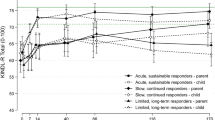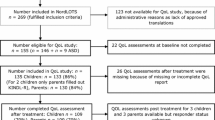Abstract
Researchers have demonstrated that quality of life (QOL) is an important construct to measure in individuals with mental health disorders, yet only a small amount of research has been dedicated to examining QOL and its response to treatment in children and adolescents with obsessive–compulsive disorder (OCD). The current study explored the psychometric properties of a measure of QOL, the Pediatric Quality of Life Enjoyment and Satisfaction Questionnaire (PQ-LES-Q), by examining the reliability, validity, and treatment sensitivity of this measure delivered in two separate RCTs for OCD (total N = 251 across both studies). Our results provide evidence for the reliability and validity of the PQ-LES-Q in adolescents with OCD (all Cronbach’s alphas >.89, convergent validity correlations significant at the p < .05 level), but that an adaptation of the measure many be necessary for valid use in younger children with OCD.
Similar content being viewed by others
References
Center for Behavioral Health Statistics and Quality (2015) Behavioral health trends in the United States: results from the 2014 National Survey on Drug Use and Health (HHS Publication No. SMA 15-4927, NSDUH Series H-50)
Mendlowicz MV, Stein MB (2000) Quality of life in individuals with anxiety disorders. Am J Psychiatry 157:669–682
Bourland S et al (2000) Quality of life in older adults with generalized anxiety disorder. Aging Ment Health 4:315–323
Orley J, Saxena S, Herrman H (1998) Quality of life and mental illness. Reflections from the perspective of the WHOQOL. Br J Psychiat 172:291–293
Endicott J, Nee J, Yang R, Wohlberg C (2006) Pediatric Quality of Life Enjoyment and Satisfaction Questionnaire (PQ-LES-Q): reliability and validity. J Am Acad Child Psychiatry 45:401–407
Norberg MM, Diefenbach GJ, Tolin DF (2008) Quality of life and anxiety and depressive disorder comorbidity. J Anxiety Disord 22:1516–1522
Eisen JL et al (2006) Impact of obsessive–compulsive disorder on quality of life. Compr Psychiatry 47:270–275
Goldberg JF, Harrow M (2005) Subjective life satisfaction and objective functional outcome in bipolar and unipolar mood disorders: a longitudinal analysis. J Affect Disord 89:79–89
Massion AO, Warshaw MG, Keller MB (1993) Quality of life and psychiatric morbidity in panic disorder and generalized anxiety disorder. Am J Psychiatry 150:600–607
Wittchen H-U, Carter R, Pfister H, Montgomery S, Kessler R (2000) Disabilities and quality of life in pure and comorbid generalized anxiety disorder and major depression in a national survey. Int Clin Psychopharmacol 15:319–328
Lydiard RB, Stahl SM, Hertzman M, Harrison WM (1997) A double-blind, placebo-controlled study comparing the effects of sertraline versus amitriptyline in the treatment of major depression. J Clin Psychiatry 58:484–491
Godfrin KA, Van Heeringen C (2010) The effects of mindfulness-based cognitive therapy on recurrence of depressive episodes, mental health and quality of life: a randomized controlled study. Behav Res Ther 48:738–746
Calabrese JR et al (2005) A randomized, double-blind, placebo-controlled trial of quetiapine in the treatment of bipolar I or II depression. Am J Psychiatry 162:1351–1360
Eng W, Coles ME, Heimberg RG, Safren SA (2005) Domains of life satisfaction in social anxiety disorder: relation to symptoms and response to cognitive-behavioral therapy. J Anxiety Disord 19:143–156
Revicki DA, Genduso LA, Hamilton SH, Ganoczy D, Beasley CM (1999) Olanzapine versus haloperidol in the treatment of schizophrenia and other psychotic disorders: quality of life and clinical outcomes of a randomized clinical trial. Qual Life Res 8:417–426
Roemer L, Orsillo SM, Salters-Pedneault K (2008) Efficacy of an acceptance-based behavior therapy for generalized anxiety disorder: evaluation in a randomized controlled trial. J Consult Clin Psychol 76:1083–1089
Volpato Cordioli A et al (2003) Cognitive-behavioral group therapy in obsessive–compulsive disorder: a randomized clinical trial. Psychother Psychosom 72:211–216
van Straten A, Cuijpers P, Smits N (2008) Effectiveness of a web-based self-help intervention for symptoms of depression, anxiety, and stress: randomized controlled trial. J Med Internet Res 10:80–89
Carlbring P et al (2011) Individually-tailored, Internet-based treatment for anxiety disorders: a randomized controlled trial. Behav Res Ther 49:18–24
Koran LM, Thienemann ML, Davenport R (1996) Quality of life for patients with obsessive–compulsive disorder. Am J Psychiatry 153:783–788
Bobes J, Gonzalez MP, Bascaran MT, Arango C, Saiz PA, Bousono M (2001) Quality of life and disability in patients with obsessive–compulsive disorder. Eur Psychiatry 16:239–245
Wagner KD et al (2003) Efficacy of sertraline in the treatment of children and adolescents with major depressive disorder: two randomized controlled trials. JAMA 290:1033–1041
Vitiello B et al (2006) Functioning and quality of life in the Treatment for Adolescents with Depression Study (TADS). J Am Acad Child Psychiatry 45:1419–1426
Lack CW, Storch EA, Keeley ML, Geffken GR, Ricketts ED, Murphy TK, Goodman WK (2009) Quality of life in children and adolescents with obsessive–compulsive disorder: base rates, parent–child agreement, and clinical correlates. Soc Psychiatry Psychiatr Epidemiol 44:935–942
Weidle B, Ivarsson T, Thomsen PH, Lydersen S, Jozefiak T (2015) Quality of life in children with OCD before and after treatment. Eur Child Adolesc Psychiatry 64:1061–1074
Varni JW, Seid M, Kurtin PS (2001) PedsQL™ 4.0: reliability and validity of the Pediatric Quality of Life Inventory™ Version 4.0 Generic Core Scales in healthy and patient populations. Med Care 39:800–812
Rosenbaum PL, Livingston M, Palisano RJ, Galuppi BE, Russell DJ (2007) Quality of life and health-related quality of life of adolescents with cerebral palsy. Dev Med Child Neurol 49:516–521
Palermo TM, Long AC, Lewandowski AS, Drotar D, Quittner AL, Walker LS (2008) Evidence-based assessment of health-related quality of life and functional impairment in pediatric psychology. J Pediatr Psychol 33:983–996
Freeman JB et al (2007) Cognitive behavioral treatment for young children with obsessive–compulsive disorder. Biol Psychiatry 61:337–343
Edelbrock Craig et al (1985) Age differences in the reliability of the psychiatric interview of the child. Child Dev 56:265–275
Endicott J, Nee J, Harrison W, Blumenthal R (1993) Quality of life enjoyment and satisfaction questionnaire. Psychopharmacol Bull 29:321–326
IsHak WW et al (2013) A descriptive analysis of quality of life using patient-reported measures in major depressive disorder in a naturalistic outpatient setting. Qual Life Res 22:585–596
Pitkänen A et al (2012) Patient education methods to support quality of life and functional ability among patients with schizophrenia: a randomised clinical trial. Qual Life Res 21:247–256
Freeman J et al (2012) The pediatric obsessive compulsive disorder treatment study for young children (POTS jr): developmental considerations in the rationale, design, and methods. J Obsessive Compuls Relat Disord 1:294–300
Eiser C, Jenney M (2007) Measuring quality of life. Arch Dis Child 92:348–350
Franklin ME et al (2011) Cognitive behavior therapy augmentation of pharmacotherapy in pediatric obsessive–compulsive disorder: the Pediatric OCD Treatment Study II (POTS II) randomized controlled trial. JAMA 306:1224–1232
Freeman J et al (2014) Family-based treatment of early childhood obsessive–compulsive disorder: the Pediatric Obsessive–Compulsive Disorder Treatment Study for Young Children (POTS Jr)—a randomozed controlled trial. JAMA 71:689–698
Nakatani E et al (2011) Children with very early onset obsessive compulsive disorder: clinical features and treatment outcome. J Child Psychol Psychiatry 52:1261–1268
Scahill L et al (1997) Children’s Yale-Brown Obsessive–Compulsive Scale: reliability and validity. J Am Acad Child Psychiatry 36:844–852
Guy W (1976) The clinical global impression scale. The ECDEU Assessment Manual for Psychopharmacology-Revised Volume DHEW Publ No ADM 76, pp 218–222
Freeman J, Flessner CA, Garcia A (2011) The Children’s Yale-Brown Obsessive Compulsive Scale: reliability and validity for use among 5 to 8 year olds with obsessive–compulsive disorder. J Abnorm Child Psychol 39:877–883
Conners CK, March JS (1996) The Conners-March Developmental Questionnaire. Multi-Health Systems, Toronto, Canada
Piacentini J, Peris TS, Bergman RL, Chang S, Jaffer M (2007) BRIEF REPORT: functional impairment in childhood OCD: development and psychometrics properties of the child obsessive–compulsive impact scale-revised (COIS-R). J Clin Child Psychol 36:645–653
March JS, Parker J, Sullivan K, Stallings P, Conners K (1997) The Multidimensional Anxiety Scale for Children (MASC): factor structure, reliability, and validity. J Am Acad Child Psychiatry 36:554–565
Rynn MA et al (2006) The psychometric properties of the MASC in a pediatric psychiatric sample. J Anxiety Disord 20:139–157
Birmaher B et al (1997) The screen for child anxiety related emotional disorders (SCARED): scale construction and psychometric characteristics. J Am Acad Child Psychiatry 36:545–553
Muris P, Merckelbach H, Schmidt H, Mayer B (1998) The revised version of the Screen for Child Anxiety Related Emotional Disorders (SCARED-R): factor structure in normal children. Pers Individ Differ 26:99–112
Cronbach LJ, Thorndike R (1971) Educational measurement. Test validation 443–507
Cohen J (1988) Statistical power analysis for the behavioral sciences, 2nd edn. L. Erlbaum Associates, Hillsdale
Iniesta-Sepúlveda M, Rosa-Alcázar AI, Rosa-Alcázar Á, Storch EA (2014) Evidence-based assessment in children and adolescents with obsessive–compulsive disorder. J Child Fam Stud 23(1455–1470):51
Aknin LB, Hamlin JK, Dunn EW (2012) Giving leads to happiness in young children. PLoS One 7:1–4
Burdette HL, Whitaker RC (2005) Resurrecting free play in young children: looking beyond fitness and fatness to attention, affiliation, and affect. Arch Pediatr Adolesc Med 159:46–50
Huppert JD, Weiss KA, Lim R, Pratt S, Smith TE (2001) Quality of life in schizophrenia: contributions of anxiety and depression. Schizophr Res 51:171–180
Author information
Authors and Affiliations
Corresponding author
Rights and permissions
About this article
Cite this article
Wellen, B., Skriner, L.C., Freeman, J. et al. Examining the Psychometric Properties of the Pediatric Quality of Life Enjoyment and Satisfaction Questionnaire in Two Samples of Youth with OCD. Child Psychiatry Hum Dev 48, 180–188 (2017). https://doi.org/10.1007/s10578-016-0662-3
Published:
Issue Date:
DOI: https://doi.org/10.1007/s10578-016-0662-3




